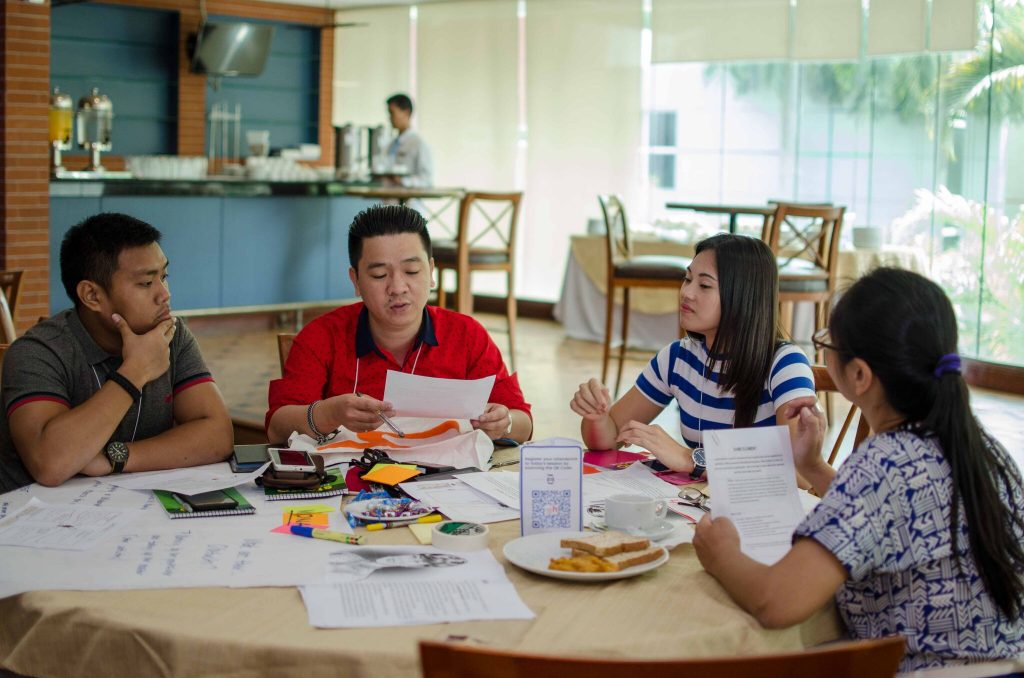1-2-4-Todos

Envolver-se todos simultaneamente na geração de perguntas, ideias, sugestões
Panorâmica
A base deste método rápido de geração de ideia é o envolvimento de todos os participantes. As pessoas refletem em torno a um tema para depois trabalhar em pares, em seguida em grupos de quatro, para compartilhar e construir em relação às ideias. Finalmente todo o grupo está envolvido em uma poderosa chuva de ideias. Os participantes obtêm know-how e imaginação quase sem perceber e constroem estratégias com suas próprias ideias. Todos contribuem, e sentem-se donos das ideias geradas.
Quando usar
- Preparação de sessões de aprendizagem e atividades em grupo.
- Rápida geração de um grande número de ideias.
- Participação de todos na procura de respostas.
- Enriquecimento da qualidade das observações e percepções antes de manifestá-las ao grupo todo.
- Construção lenta em direção a um entendimento de consenso ou compartilhado.
- Para o feedback após um discurso ou apresentação, como uma alternativa para perguntar: “Alguma pergunta?”
- Para promover a conversa espontânea que começa depois que o tema de uma reunião é anunciado.
- Realização de progressos em uma discussão estagnada.
- Em vez de um líder “dizer” às pessoas o que pensar e fazer (frequentemente sem intenção) ou por um grupo que tende a ser excessivamente influenciado por seu líder.
Como aplicar
Começar:
Os participantes são interrogados com relação à apresentação de um tema, a um problema para resolver ou a uma proposta: “Que oportunidades você vê para fazer progressos neste desafio?
Como você lidaria com esta situação? Que ideias ou ações você recomendaria?”.
Montagem:
Um número ilimitado de grupos pode participar da atividade. Os participantes estão frente a frente quando se trabalha em duplas e em grupos de quatro.
Materiais:
Não e necessário usar cadeiras ou mesas. Bloco de notas para registrar observações e percepções.
Tempo/Passos:
- 1-2 minutos: Os participantes passam este tempo em reflexão silenciosa em um desafio comum, dentro da pergunta: “Que oportunidades você vê para que isto (alvo) aconteça?”
- 5 minutos: Em duplas os participantes geram ideias, com base em ideias surgidas na reflexão.
- 5 minutos: As ideias são compartilhadas em grupos de quatro (as semelhanças e as diferenças são percebidas neste momento).
- 5 minutos: O moderador pede a cada grupo para compartilhar uma ideia emergente, “Que ideia se destacou em seu diálogo?”
- Cada grupo compartilha, com todos, uma ideia importante. Convida cada grupo para compartilhar uma opinião, mas não repetir opiniões já comunicadas.
- Repita este ciclo de trabalho se for necessário.
Como adaptar
- Se você quiser despertar um pensamento mais inovador, comece com “Se a nossa abordagem para________(fazer referência ao tópico/desafio em questão) foi totalmente obliterado na noite passada, que partes você restabeleceria?” e novamente,”Que novas funções ou atributos você acrescentaria?”
- Use notas autoadesivas e regras de Brainstorming – (Chuva de ideias) na 2ª e 3ª rodada.
- Unir as ideias que surjam para Design Storyboards – (Projetar um Roteiro sequencial), 25/10 Crowd Sourcing (Colaboração aberta de tarefas), Improv Prototyping – Prototipagem de improviso, Ecocycle Planning – (Planejamento de Ecociclos).
- Passar de grupos de quatro para grupos de oito, antes de ampliar para um grupo todo, tentando chegar a um consenso entre os grupos.
Estudo de caso
Título:
Abordagem de um tema de alto nível através de um pensamento inovador
Atividade:
Reunião de equipe ICTS
Contato:
Minori Hara, m.hara@itcilo.org (ICTS)
Descrição:
No início da reunião, os membros da equipe foram informados que a perspectiva da reunião ia ser diferente da habitual. Os membros da equipe têm que pensar a respeito de “Como gerar valor de negócio em ICTS?”. O tópico não foi relacionado ao dia-a-dia de trabalho dos membros e foi orientado para o futuro. Com a aplicação da metodologia 1-2-4-todos os participantes, com uma posição mais júnior ou aqueles que por natureza são mais introvertidos, têm a oportunidade de participar em pé de igualdade com membros sênior. A metodologia permite aos participantes começar individualmente e em pequenos grupos, antes de apresentar as ideias para toda a equipe.
Dicas
- Ajudar firmemente em uma reflexão calma antes das conversas em duplas.
- Peça a todos para anotar suas ideias durante a reflexão silenciosa.
- Use campainhas para anunciar as transições.
- Use um moderador e um assistente para ajudar a registrar as ideias se o grupo for grande.
- Separar e proteger a geração de ideias da discussão do grupo todo. Defina uma regra de ter um dialogo por vez no grupo.
- Deixar juízo de lado, apresentar ideias visuais, ser criativos.
- Quando chegar um nível de estabilização ou de consenso, mudar para outra forma de expressão (por exemplo, de improvisar, esboçar, storytelling).





